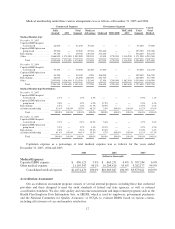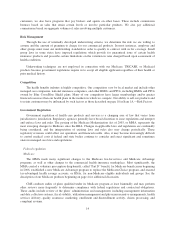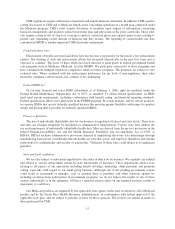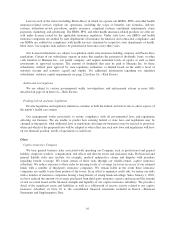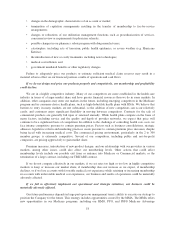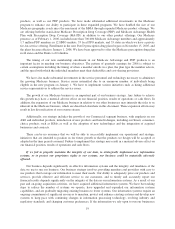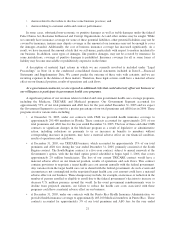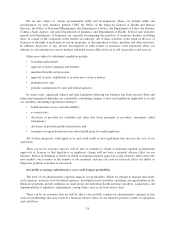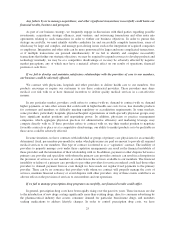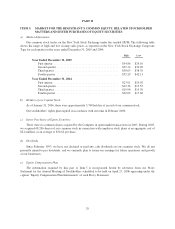Humana 2005 Annual Report Download - page 32
Download and view the complete annual report
Please find page 32 of the 2005 Humana annual report below. You can navigate through the pages in the report by either clicking on the pages listed below, or by using the keyword search tool below to find specific information within the annual report.December 31, 2005. We currently have Medicaid contracts with the Puerto Rico Health Insurance
Administration that expire on June 30, 2006. We are preparing to bid on the new contracts that will be
effective July 2006 although a request for such proposal has not yet been issued by the Puerto Rico
Health Insurance Administration. The loss of these contracts or significant changes in the Puerto Rico
Medicaid program as a result of legislative or administrative action, including reductions in payments to
us or increases in benefits to members without corresponding increases in payments, may have a
material adverse effect on our financial condition, results of operations and cash flows;
• the possibility of temporary or permanent suspension from participating in government health care
programs, including Medicare and Medicaid, if we are convicted of fraud or other criminal conduct in
the performance of a health care program or if there is an adverse decision against us under the federal
False Claims Act;
• CMS has implemented a risk adjustment model which apportions premiums paid to Medicare health
plans according to health severity. A risk adjustment model pays more for enrollees with predictably
higher costs. Under the new risk adjustment methodology, all Medicare health plans must collect,
capture and submit the necessary diagnosis code information from inpatient and ambulatory treatment
settings to CMS within prescribed deadlines. The CMS risk adjustment model uses this diagnosis data to
calculate the risk adjusted premium payment to Medicare health plans. CMS is transitioning to the risk
adjustment model for Medicare Advantage plans as follows: 50% in 2005, 75% in 2006 and 100% in
2007. The PDP payment methodology is based 100% on the risk adjustment model beginning in 2006;
• commensurate with phase-in of the new risk-adjustment methodology, payments to Medicare
Advantage plans have been increased by a “budget neutrality” factor. The budget neutrality factor was
implemented to prevent overall health plan payments from being reduced during the transition to the
new risk-adjustment payment model. The payment adjustments for budget neutrality were first
developed in 2002 and began to be used with the 2003 payments. The budget neutrality adjustment will
begin phasing out in 2007 and will be fully eliminated by 2011. This does not mean, however, that the
aggregate per-member payments to Medicare plans will be reduced. As plans enroll less healthy
beneficiaries, the need for the budget neutrality adjustment declines as the underlying risk adjusted
Medicare rates paid to plans increase to account for their enrollees’ greater healthcare needs. As a result
of the CMS payment methodology described above, the amount and timing of our CMS monthly
premium payments per member may change materially, either favorably or unfavorably;
• future changes to these government programs which may affect our ability or willingness to participate
in these programs;
• higher comparative medical costs;
• government regulatory and reporting requirements; and
• higher marketing and advertising costs per member as a result of marketing to individuals as opposed to
groups.
Our industry is currently subject to substantial government regulation, which, along with possible
increased governmental regulation or legislative reform, increases our costs of doing business and could
adversely affect our profitability.
The health care industry in general, and health insurance, particularly HMOs and PPOs are subject to
substantial federal and state government regulation.
Our licensed subsidiaries are subject to regulation under state insurance holding company and Puerto Rico
regulations. These regulations generally require, among other things, prior approval and/or notice of new
products, rates, benefit changes, and certain material transactions, including dividend payments, purchases or
sales of assets, intercompany agreements, and the filing of various financial and operational reports.
22


